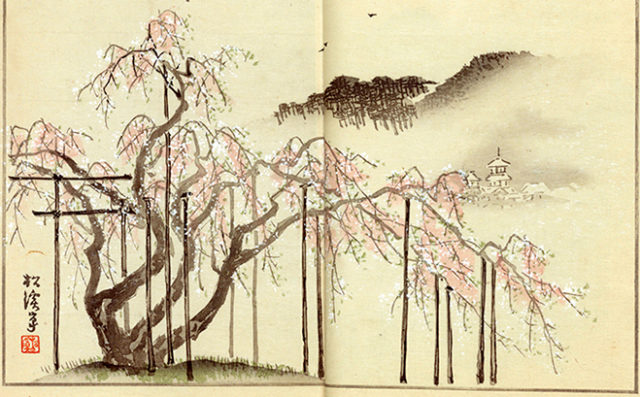
By David Yamaguchi,
ACROSS RECENT YEARS, this paper has annually covered many topics related to cherry blossoms. Not yet examined, however, has been their historical peak flowering dates in Kyoto, Japan. This record is of interest because it is the longest such record in the world. One question makes such observations especially relevant today. Do these data provide evidence of human-caused climate warming?
The enhanced-graphics version of the Kyoto flowering dates that appeared in The Economist (April 7, 2017) are reproduced at right.
To understand more of what lies behind this graphic, we must follow the data to its source, the home page of Yasuyuki Aono of Osaka Prefectural University. From Prof. Aono’s data, we learn that the first recorded Kyoto peak flowering was on April 1, AD 812. this was during the reign of Emperor Saga (AD 809-823), who promoted cherryblossom viewing parties, hanami, in his courtyard.
From that promising beginning, at first there are many missing observations, so that by AD 900 only fourteen had been made. Over succeeding centuries, however, the observations begin to be made more regularly, so that gaps gradually shorten and taper off across the centuries. Since 1900, there are only three missing observations—1919, 1921, and 1945—when all were preoccupied with other activities. Likely explanations for these anomalies include the Spanish Flu pandemic, which killed over 50 million worldwide, the firebombing of Japan, and one other unknown distraction.

What is striking about the plotted series as a whole is how it plummets from about 1840. Aono’s data identify the last date before the plunge as April 30, 1839. After that, the Kyoto cherry trees begin blooming earlier and earlier in spring. No similar prolonged drop appears earlier in the record, suggesting that the recent early flowering dates are not natural. The Kyoto cherry blossom record serves as a testament to the remarkable length of literacy in Japan. It also illustrates the value of such long natural records to help us understand our present-day world.
The Kyoto blossoming dates accord with many other lines of evidence that human-induced climate warming is indeed occurring.



